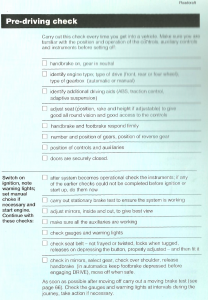What do the DVSA think first off?
The candidate should ensure that the handbrake is applied and the gear lever/selector is in neutral before starting the engine.
That’s it – all this rigmarole about adjusting your headrest to the top of your ears and adjusting the mirrors, you don’t have to go through that at the start of the test – and as you’ve driven the car there anyway it should already be correctly adjusted.
Note it’s handbrake and then neutral. For the same reason it is when you come to a stop, (I keep coming across drivers going Neutral then Handbrake)
Anyway I digress
A lot of time seems to be spent on pre-drive checks or ‘scripts’ for civilian advanced tests. My view is, is its the drive that counts not time spent chatting in the car.
Pre-Drive checks were introduced because Roadcraft is the “Police Drivers Handbook”, and service staff jump in and out of different vehicles every day.
The earlier versions of Roadcraft were generally silent on it with the exception of
“If called on to drive a strange car, a driver should realise that he cannot with safety, drive it as fast as one to which he is accustomed. However comfortable he may feel in the driving seat his controlling movements particularly in an emergency will be noticeably slower and even prone to misjudgement if the controls are slightly differently placed. Its road holding, accelerating and braking power may be different…….All these things must be borne in mind”
The standard one I’ve always used, and which was still being used in Police Training 10 years ago comes from the last edition of ‘proper’ Roadcraft
“Before moving off the driver should familiarise himself with the position and operation of the controls and instruments.
The following routine should be carried out:
a) Ensure handbrake is on and check both hand and foot brake operation
b) Check the gear level is in neutral
c) Adjust seat, mirrors and steering wheel as appropriate
d) check doors for security
e) check position of controls and auxiliaries
f) switch on ignition, note warning lights, start engine. Check instruments and warning lights. Ensure sufficient fuel for journey
g) seat belts to be worn and properly adjusted
h) As soon as possible after moving off I will carry out a moving brake test. If I am unable to do so I will brake early for the first hazard. The vehicle should pull up on a straight course without swerving to either side and without any unusual noises. ”
The original IPSGA Version of Roadcraft rewrote this as a check list shown here,  whereas the current 2015 edition is a complete mess, with a raft of checklists at the back, its no longer clear or concise at all.
whereas the current 2015 edition is a complete mess, with a raft of checklists at the back, its no longer clear or concise at all.
The current Ambulance response driving handbook check list has 10 pages covering the PDC.
There’s another Commentary starting phrase you sometimes come across which I’ve heard originated with a Scottish Police Force:
“Today as all days, I will drive my car according to the system of car control, which is a way of approaching and negotiating hazards that is methodical, safe and leaves nothing to chance”.
“To do this will require me to apply concentration and alertness in order to drive my car safely, smoothly progressively and well”.
“I will formulate my driving plan on three things; what I can see, what I cannot see and what I might reasonably expect to occur”.
“By driving my car to the system of car control, I will at all times observe, plan and anticipate to ensure maximum vehicle stability, in response to all road and traffic conditions”.
Note the Pre-Drive Check is a different check to the Vehicle Road-worthiness check, POWER, POWDER, FLOWER, FLOWERY etc and would be covered (if at all) on test by an external walk-round with the examiner. It’s even two separate checklists in Roadcraft.
Sitting in the car rambling on about the tyre tread depth and oil levels just stretches out the start even loooonnnnger.
The running brake test – some sources including earlier Roadcraft state this to be from around 30mph. I’d say this was unnecessary and potentially difficult in modern traffic conditions depending on where you start the drive from.
If you’ve had to use the brakes to drive to a location to do a moving brake test you’ve kind of defeated the point of the test in the first place. You just need sufficient speed to indicate if the vehicle is going to pull under braking.

